
CROMPTON COUSINSThis page contains locomotive classes closely related to Class 33s. It includes locomotives built by BRCW, or having a Sulzer 8LDA engine, or Crompton-Parkinson traction motors. Types represented are BR Classes 26, 27, 44, 45, Lion and JNR DF50. For information about other Sulzer engined locos that do not fall into these criteria, see SulzerTwo History page. |
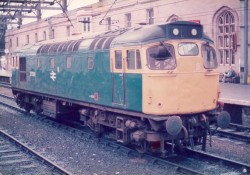
|
Australian Commonwealth Railways NSU
These A1A-A1A 1067mm narrow gauge locomotives were built in 1953 and 1954 by the BRCW in Smethwick. They had the 955hp 6LDA28 engine, with Crompton Parkinson electrical equipment. They were designed for use on the Central and Nothern Autralia 3ft 6in gauge lines, and were fitted for multiple operation in back to back mode. They were fitted for train air braking. Four standard gauge bogies were alos supplied to enable them to operate in other parts of Australia. These bogies enabled trial runs to be made on BR between Birmingham and Banbury.
BRCW Works Numbers: DEL1 - DEL14
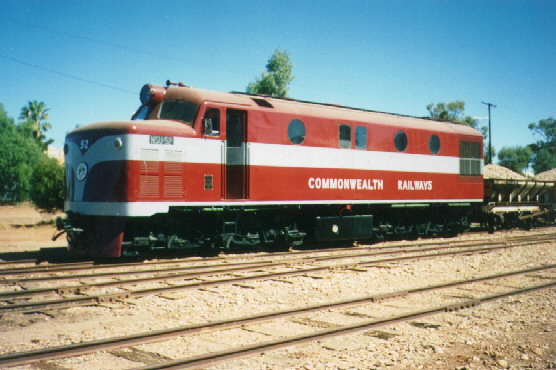
|
Chris Carpenter |
There were 14 built, numbered NSU 51 - NSU 64. All were withdrawn by 1987, but all are still in existence. For a comprehesive review of these locos, see Nic Doncasters NSU page.
Sierra Leone Development Company Locomotives
These A1A-A1A Sulzer 6LDA28 powered locomotives were identical to the Australian NSU locos, except they were fitted for vacuum braking of trains. They were built by the BRCW in Smethwick, 5 in 1954, and 1 in 1960. These locos were number 100 to 105.
BRCW Works Numbers: DEL15 - DEL19 (101 - 105) and DEL259 (100) ?
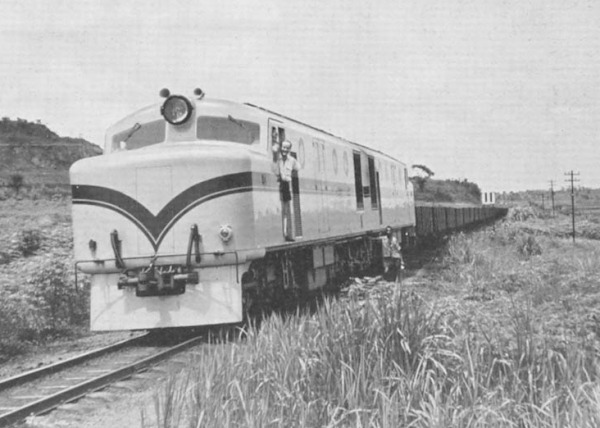
|
Two Siearra Leone BRCW/Sulzer/Crompton Locomotives. Taken from Sulzer Publicity Brochure. David Hills |
Coras Iompair Eireann 101 B Class
Twelve locomotives were built in 1956 for the Irish 5ft 3in system. They were A1A-A1A locomotives fitted with Sulzer 6LDA28 engines and Metropolitan Vickers electrical equipment.
BRCW Works Numbers: DEL20 - DEL31
No Picture at present
They were numbered B101 to B112, all were withdrawn between 1969 and 1977 and scrapped, except for B103 which is preserved at Carrick-on-Suir.
Ghana Railway And Harbours Administration Locomotives
These thirteen locos were built in 1957, and were single cabbed general purpose machines. They had a Davey Paxman 12RPH11 engine of 410 bhp, and Crompton Parkinson electrical equipment. They were of Bo-Bo configuration and ran on the Ghanan Railways 3ft 6in gauge system.
BRCW Works Numbers: DEL32 - DEL44
No Picture at present
Nothing furthur is known about the history of these locos.
BRCW 1160hp British Railways Type 2
These Bo-Bo locomotives later became known as Class 26, and are similar in many ways to the Class 33. They have the smaller 6 cylinder version of the Sulzer engine 6LDA28, and also have Crompton Parkinson traction motors. They were built at Smethwick in 1958 and 1959, and totalled 47 locos, numbered D5300 to D5346. Their maximum speed was 80mph. Originally allocated for Kings Cross suburban duties, they then became Scottish Region machines for the rest of their working lives. They were renumbered 26001 to 26046, except for D5328 which was scrapped in 1972.
BRCW Works Numbers: DEL45 - DEL91
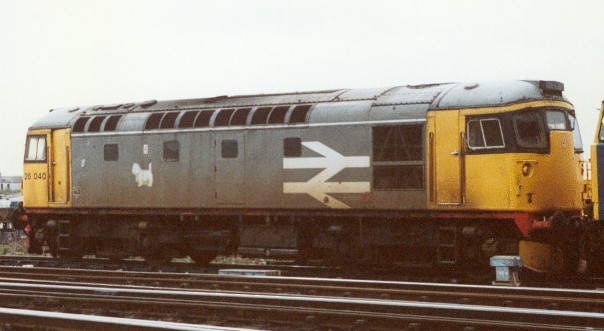
|
26040 at Carlisle on the 8th April 1989 Jon Biglowe |
A few were scrapped in the 1970s, but most of them lasted until 1992/3. There are 13 members of the class preserved.
BRCW 1250hp British Railways Type 2
Later known as Class 27, the 69 members of this class were built by BRCW at Smethwick in 1961-62. They featured the slightly more powerful Sulzer 6LDA28-B engine of 1250hp. Unlike the Class 26s, they had GEC traction motors. They were faster than the 26s, with a maximum speed of 90mph. They were originally numbered D5347 to D5415, later becoming 27001 to 27069. Some were reclassified as steam heating 27/1 (27101 to 27112), and electric heating 27/2 (27201 to 27212) for Glasgow to Edinburgh push-pull duties. After the end of these services, the electric heat machines had their ETH equipment removed and reverted to 27/0.
BRCW Works Numbers: DEL190 - DEL258 (Class 33s were DEL92 - DEL 189)
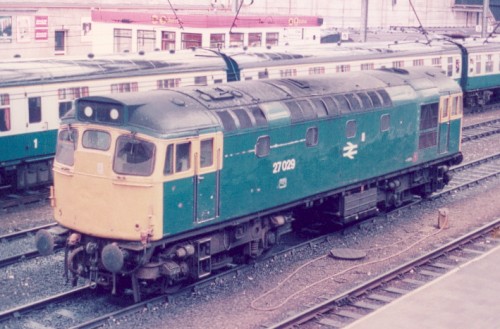
|
27029 at Carlisle on the 8th October 1983 Jon Biglowe |
A few were scrapped in the 1970s, but most remained in service until the middle 1980s, with the last going in 1987. There are 8 members of the class preserved.
BRCW Lion
T his engine, numbered D0260, was built in 1962 by the BRCW, it was intended to be the forerunner of a large batch of standard Type 4 locomotives. This did not happen, and BRCW went into liquidation, the standard Type 4 being the Brush/Sulzer Class 47. Lion had a 2750hp Sulzer engine the 12LDA28-C, the most powerful single engine available at the time. It was fitted with 6 A.E.I traction motors, and had steam and electric heating.
BRCW Works Number DEL260, hence it's running number.
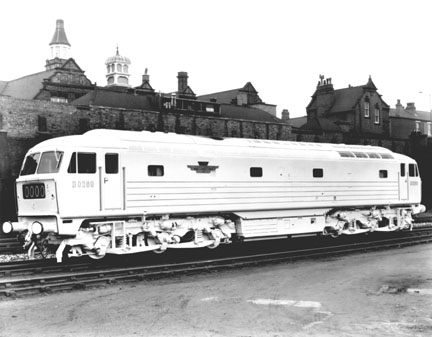
|
D0260 Lion in April 1962 at the BRCW Yard in Smethwick, Birmingham. Official photo, now in the David J Rogers collection |
It was withdrawn in September 1963, and towed to Shaws of Sheffield, where it was cut up in November of the same year.
Swiss Federal Railways Locomotives 1001 And 1002
These two BoBo locos had the same 8LDA28 engines as Class 33s, and weighed 66 tons. They were built by SLM in 1939, with BBC electrical equipment. They were classed as Bm 4/4 II by the SBB and later renumbered 18451 and 18452.
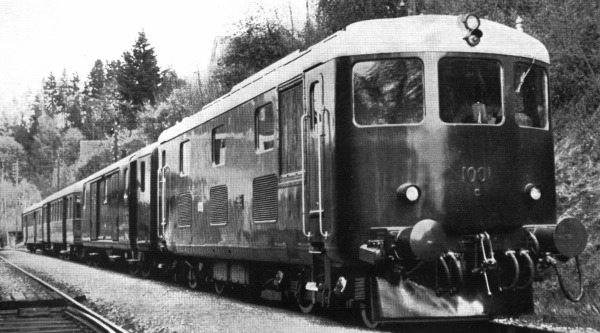
|
SBB 1001, later 18451 shown in mid 1939 Daniel Osborne |
One loco survives, 18451 is still owned by SBB, but only being used occasionally as a museum loco.
JAPANESE NATIONAL RAILWAY DF50
All the information about these locos has been supplied by Daisuke Yanase.
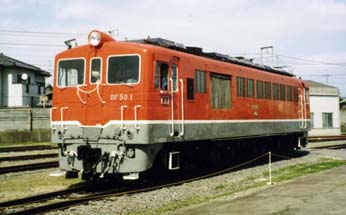
|
JNR DF 50 1, the first member of the class Daisuke Yanase |
The JNR DF50, where 'D' stands for 'diesel-powered'; 'F' for six driving axles; '5*' for 'a locomotive whose maximum speed is 90 km/h or greater.' This 86 ton BoBoBo locomotive was designed in the mid '50s to replace steam engines on those 'sooty' lines in Japan. It might be unusual, but DF50s were fitted with either of two types of diesel motors:
DF50 1-65:
Powered by Swiss Sulzer 8LDA25A, 1200 hp / 600 kW; built Mitsubishi Heavy Industries
1957-1962.
DF50 501-573:
Powered by German M.A.N V6V22/30mA, 1400 hp / 684 kW; built by Kawasaki (37),
Hitachi (34), Toshiba (2) 1958-1963.
The engines in these locos, the 8LDA25A, was basically the same as the Class 33, only an earlier version rated at 1200 hp compared with the 33s 1550 hp. They were built to the Japanese narrow track gauge of 3ft. 6in, within a loading gauge of 10ft. by 13ft. The last DF50 was withdrawn from operation in August 1983, but there are 3 preserved. Only one is operational, it is kept in the Tadotsu garage, Shikoku. It performs on demonstration runs at least twice a year. These runs are not long distance drives, just shuttling for some 200m in the garage yard. But you are allowed into the cab.
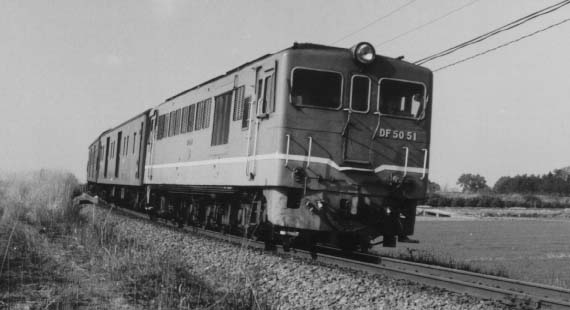
|
JNR DF 50 51 Daisuke Yanase |
British Railways Derby 2300hp Type 4 "Peak" - Class 44
These 1Co-Co1 locomotives later became known as Class 44. They have a larger Sulzer engine, the 12 cylinder 12LDA28-A, and 6 Crompton Parkinson CP171-B1 traction motors. They were built as a prototype for the BR "Modernisation Plan" at Derby Works in 1959. There were 10 locos, numbered D1 to D10. They weighed 133 tons, and their maximum speed was 90mph. Originally allocated for mixed traffic duties, they ended their days working coal trains. They were renumbered 44001 to 44010. They were all named after English and Welsh peaks.
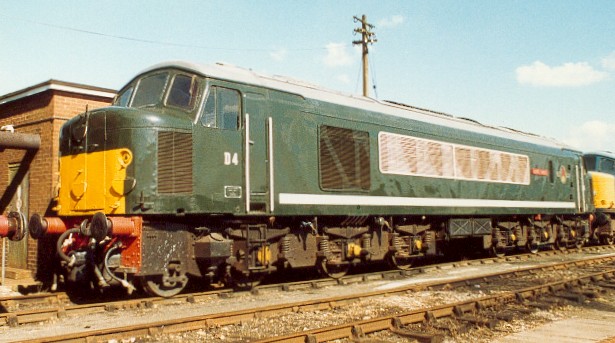
|
D4 "GREAT GABLE" at Basingstoke on the 26th September 1987 Jon Biglowe |
They lasted in service until 1980. Two have been preserved, D4 "GREAT GABLE", and D8 "PENYGHENT".
British Railways Derby 2500hp Type 4 - Class 45
These 1Co-Co1 locomotives were the production version of the Class 44, described above. They were also called "Peaks", but none were actually named after peaks. They have an uprated Sulzer 12 cylinder engine, the 12LDA28-B, and 6 Crompton Parkinson CP172-A1 traction motors. They were built at Derby Works in 1960-62. There were 127 locos, numbered D11 to D137, later 45001 to 45077, and 45101 to 45150. The 45/1 were fitted with electric train heating equipment. They weighed 135 tons, and their maximum speed was 90mph. Worked as mixed traffic machines, mainly on the London Midland Region, and especially the Midland Railway routes, such as London St. Pancras to Derby. About 25 of the class were named after English Army Regiments.
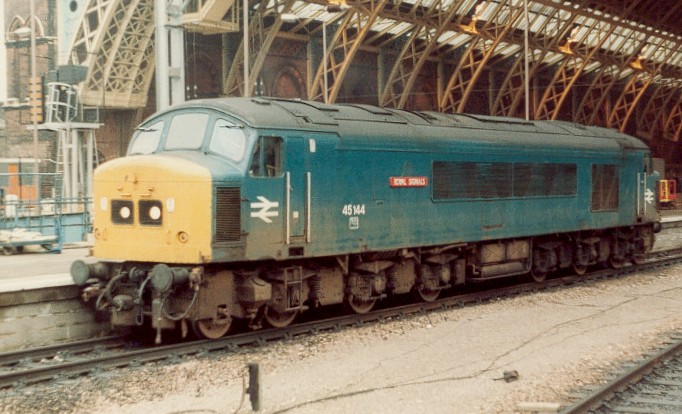
|
45144 "ROYAL SIGNALS" at St. Pancras on the 31st December 1982 Jon Biglowe |
They lasted were withdrawn from service between 1977 and 1991, mostly 1985-88. Eleven members of the class have been preserved. There was a final development of the "Peaks", the Class 46, but these had Brush traction motors, so are not included here.
Others Worthy Of Mention
The following don't fall into the BRCW or 8LDA or Crompton category, but are worthy of mention. Thanks to Daniel Osborne for the most of the information.
PLMA (Paris Lyon Mediterrian Alger) 2-Co-2
1 locomotive, built by the Compagnie des Forges et Acieres de la Marine et d'Homecourt,
France 1933. Standard Gauge Diesel Electric with MAN 686kW engine.
Rebuilt in1938 by Als-Thom France with 2 x 6LDA25 Sulzer engines output total 895kW.
Maximum Speed 121Km/h. Scrapped 1958.
NRC (Nigerian Railway Corporation) 1401 - 1429
29 locos, built Metro-Cammell 1965, Sulzer 6LDA28C. Four locos (1425 - 1428)
later transfered to Nyasaland Railways (Malawi) with the same numbers.
The 4 Malawi locos are now owned by CEAR, but not in
operational condition. They may however be converted into Slugs.
NRC (Nigerian Railway Corporation) 1425 - 1428
4 locos, built Metro-Cammell 1966, Sulzer 6LDA28C. Replacement for those that went to Malawi.
Nyasaland And Trans-Zambesian Railways 200 - 204 "Zambesi Class"
5 locos, built by Metro-Cammell Birmingham 1962, Sulzer 6LDA28B of 1200hp,
AEI electrics, 81ton, 50mph. Renumbered Malawi Railways 400-404
in 1967 after Nyasaland become independent
(as Malawi), and the assets were split between Malawi and
the privately owned rans-Zambesian Railway. These locos are all due to be scrapped soon.
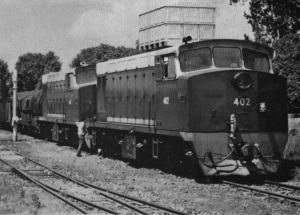
|
Malawi Railways 402 Daniel Osborne |
Nyasaland And Trans-Zambesian Railways 205-207 "Zambesi Class"
3 locos, built Metro-Cammell 1963, Sulzer 6LDA28B. These engines stayed with
these numbers as they belonged to Trans-Zambesian Railways.
Nyasaland And Trans-Zambesian Railways 208-214 "Zambesi Class"
7 locos, built Metro-Cammell 1967, Sulzer 6LDA28B. These locos also kept
their numbers and became TZR assets.
Malawi Railways 405 - 409 "Zambesi Class"
5 locos, built Metro-Cammell 1968, Sulzer 6LDA28B. Locos were
Malawi Railways from the start. They have all recently been sold to a scrap company.